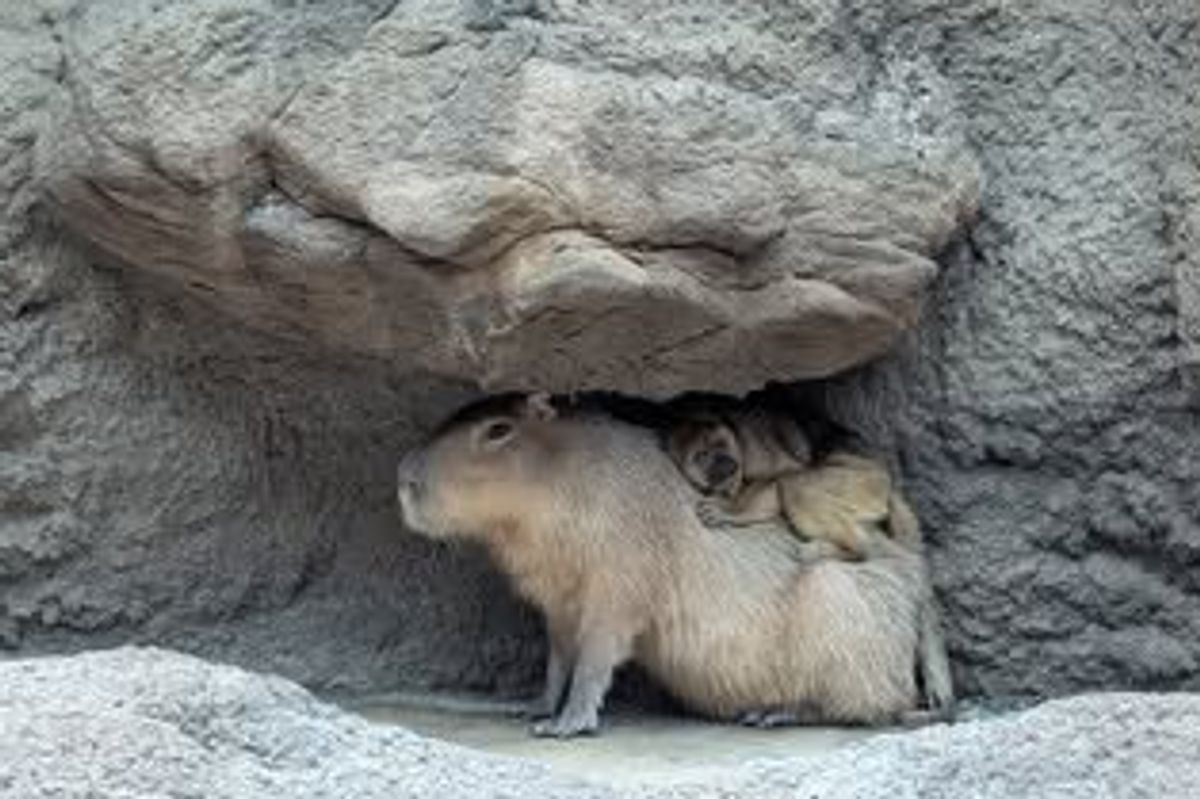Denver Zoo's howler monkey and capybara have become surprise best friends
Baya and Rebecca = "cuteness overload."

A howler monkey naps on the back of a capybara.
One never knows when or how they will meet their BFF, but where better than the Tropical Discovery indoor rainforest at the Denver Zoo? It just so happened that a six-year-old capybara named Rebecca and a 16-year-old howler monkey called Baya, both needed a little sisterhood in a "pen packed with boys" as they were put together as part of the Conservation Alliance.
On the Denver Zoo's Facebook page, they share a cuddly picture of the besties and write, "You're welcome for the cuteness overload."
One Facebook commenter jokes, "Someone is definitely going to start making capybara-monkey plush animal sets now. And I’ll bet 'monkey-riding-a capybara' will become a motif in children’s pajamas. Just wait for it."
Another has actually met the pair. "We saw Rebecca giving Baya a piggyback ride one day! So funny!"
This commenter gives insight as to just how unique this paring is. "I studied wild (mantled) howler monkeys in Costa Rica, and the interesting thing about this is that howlers are some of the most anti-social monkeys. Even living in troops, they have < 3 min. of direct social interaction with one another a day. They spend all their time eating and sleeping--not cuddling, And they are some of the most averse monkeys to coming down to the ground, doing it only in the most dire of emergencies. So seeing one on the ground and cuddling with a capybara is quite unusual!"

National Geographic somewhat backs up this claim. They also report that these are the loudest of monkeys (hence the name) and that they don't often interact with others below the treetops. "They are at home in the forest, they hardly ever leave the treetops. They don't move very far each day, feeding leisurely at the very top of the forest canopy. Howlers mainly eat leaves, as well as fruits, nuts, and flowers. Howler monkeys get almost all the water they need from the food they eat. One of the few times they can be spotted on the ground, however, is during very dry spells when they need to find extra water."
As for the capybara, the San Diego Zoo's website asks, "Is it a beaver without a tail? A hairy pig without a snout? No, it’s a capybara, the largest rodent in the world! At only two feet tall, they add, "Originally thought to be a pig of some sort, we now know that the capybara is a rodent, closely related to cavies and guinea pigs."

In an article for Axios Denver, writer Alayna Alvarez shares that, although the two cuties are South American, they most likely would not have met in the outside world. Alvarez spoke with Jessica Newell, the Denver Zoo's assistant Tropical Discovery curator, who says that it's the older monkey who seeks comfort in the larger capybara. "Rebecca's pretty calm, and Baya's able to go to her for comfort and support …They are very content with each other."
She also explains the timeline of their friendship. Baya is a single monkey-mom with three sons who came to Denver a few months back from the Florida Brevard Zoo. Rebecca has been in Denver a few years and came "with her mate Roy."
In just a few days, there are already tens of thousands of Insta-likes and tons of comments. Many ask questions, which are answered on the Denver Zoo Insta page. One asks, "Omg, do they live in the same enclosure?" A person answers, "Yes! They share a habitat with Rebecca's Cappy husband Roy and Baya's sons, (I don't recall their names.)
Another shares, "Capybaras are nature's universal moms. Every animal wants to get some of that nurturing love." This Instagrammer summed up the beautiful friendship, quipping, " "It's her emotional support capybara."

